Economist Amartya Sen exposed the flaws of the over simplistic GDP centered development model and presented very forceful pragmatic arguments to make it people centric. His ‘capability approach‘ puts people in the center of the process of development, replacing the GDP numbers. Here development is seen as a process of enhancing people’s capabilities by expanding their real freedoms. People’s capability to function effectively is what matters the most, and that depends upon many things that don’t go into the GDP calculations. Once seen in this perspective, ‘poverty’ becomes very easy to understand: ‘Poverty’ is now seen as a situation where people lack the most basic capabilities to lead a reasonable life. In other words, poverty means living a ‘constricted life’ – it’s a life without enough freedoms (choices) leading to shortage of essential goods needed to survive. Higher constriction means highly reduced capabilities, leading to higher levels of misery. Sen’s arguments in the capability approach automatically lead to the idea of ‘freedom’ enjoyed by people because it has a direct impact on their ‘capability to function’. Extended further, the analysis of ‘freedom’ reveals ‘actionable tools’ for developmental course correction.
What should be the Focus of Development: GDP or people’s Well-being ?
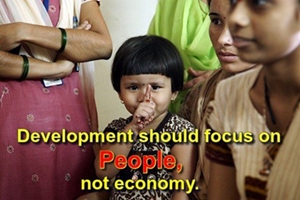 Amartya Sen’s idea of capability theory can’t be properly understood without first revisiting the concept of “development”. Unfortunately, the agenda of ‘development’ was hijacked by economists long ago. As a result, today when people talk of development they are merely talking of “economic development” which was further restricted to looking at the GDP growth (ie., economic expansion). People became invisible or get reduced to the status of merely goods and services producers and as the end consumers. People’s human-ness has little relevance in the GDP driven development perspective. It is intrinsically a production/consumption oriented model – produce more and consume more. People are supposed to be more “developed” if they consume more, and vice versa! Everything is seen in the context of consumption of goods and resources; it is an input driven ideology.
Amartya Sen’s idea of capability theory can’t be properly understood without first revisiting the concept of “development”. Unfortunately, the agenda of ‘development’ was hijacked by economists long ago. As a result, today when people talk of development they are merely talking of “economic development” which was further restricted to looking at the GDP growth (ie., economic expansion). People became invisible or get reduced to the status of merely goods and services producers and as the end consumers. People’s human-ness has little relevance in the GDP driven development perspective. It is intrinsically a production/consumption oriented model – produce more and consume more. People are supposed to be more “developed” if they consume more, and vice versa! Everything is seen in the context of consumption of goods and resources; it is an input driven ideology.
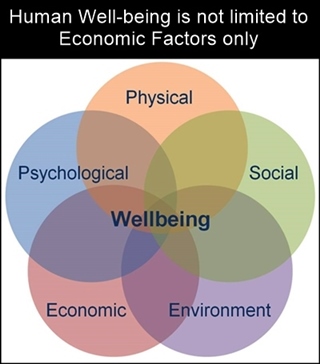 While economic expansion is useful as it adds to the material comfort people, the human well-being is multi-faceted, it also depends upon many non-material things – after all, people are psychological, social and political beings. Therefore, the primary focus of development should be the “people” as human beings; not on the expansion of the economy. It means shifting from the narrow resource (input) driven “economic development” to a broader well-being (end-result) centered “human development”. [Explore: Development beyond GDP]
While economic expansion is useful as it adds to the material comfort people, the human well-being is multi-faceted, it also depends upon many non-material things – after all, people are psychological, social and political beings. Therefore, the primary focus of development should be the “people” as human beings; not on the expansion of the economy. It means shifting from the narrow resource (input) driven “economic development” to a broader well-being (end-result) centered “human development”. [Explore: Development beyond GDP]
Amartya Sen’s capabilities approach offers a comprehensive perspective of development where everything revolves around enhancing people’s well-being.
Capability Approach: A Comprehensive Development Paradigm
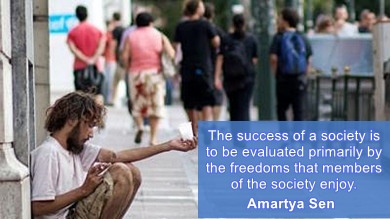 In the recent decades Amartya Sen’s Capability Theory has left a profound impact on the discourse on progress and development. Rather than goods and resources (the inputs), the focus of Sen’s capability approach is people and their capabilities (the end-results). It also provides an alternative and more comprehensive perspective on the issues like poverty, inequality, gender bias, and social exclusion that are hardly touched by the economic perspective.
In the recent decades Amartya Sen’s Capability Theory has left a profound impact on the discourse on progress and development. Rather than goods and resources (the inputs), the focus of Sen’s capability approach is people and their capabilities (the end-results). It also provides an alternative and more comprehensive perspective on the issues like poverty, inequality, gender bias, and social exclusion that are hardly touched by the economic perspective.
Sen’s approach is both comprehensive and flexible and is people centric. Now people are no more robotic producers and consumers. If the GDP growth model dis-empowers them, the capabilities approach makes their empowerment the central issue. Rather than talking of some theoretical equality of people or seeing them in terms of numbers, the capability approach explicitly recognizes the differences among individuals. It also recognizes that people’s abilities are affected by external factors — such as interaction with other people, social arrangements, access to infrastructure and public services, prejudices and discriminations, extent of opportunities to participate in social and political activities, extent of freedom to speak and influence state policies, and so on.
Historical Roots of Capability Approach
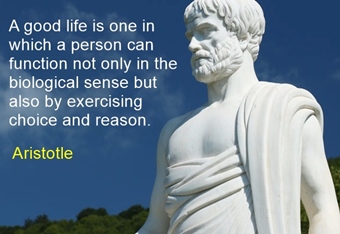 The origin of the idea of functionings and capability can be traced back to Aristotle in the 4th century BC. In Politics, while discussing the idea of the “best political arrangement,” Aristotle argued that the aim of political planning is the distribution of the conditions for a good life to the people in the society. These conditions are understood by him as producing the possibilities of having a “flourishing life. He asserted that a good life is one in which a person can function not only in the biological sense but also by exercising choice and reason. Thinkers like Adam Smith and John Stuart Mill also gave similar ideas of good human life.
The origin of the idea of functionings and capability can be traced back to Aristotle in the 4th century BC. In Politics, while discussing the idea of the “best political arrangement,” Aristotle argued that the aim of political planning is the distribution of the conditions for a good life to the people in the society. These conditions are understood by him as producing the possibilities of having a “flourishing life. He asserted that a good life is one in which a person can function not only in the biological sense but also by exercising choice and reason. Thinkers like Adam Smith and John Stuart Mill also gave similar ideas of good human life.
Then in the 19th century, Marx and Engels described a commendable human life as not only one in which the person’s material needs are satisfied, but also as one in which people are able to think freely and use reason. For Marx, the biological needs of eating, drinking, or procreation, are “genuinely human functions,” but without freedom of choice and freedom from immediate want, these will be performed in a merely animal way. Amartya Sen’s reasoning along such lines crystallized in the concept of the capability approach of development.
The Capability Approach of Development
 Amartya Sen’s capabilities approach revolves around “people” seen as human being with emotional and psychological demands; it sees development as expansion of people’s capabilities – it is an enabling (empowering) preposition. It aims to enhance people’s well-being by expanding their capabilities which is connected to freedom of choices. It explicitly recognizes the presence of diversities and the multidimensional nature of human well-being. The emphasis is not only on how people actually function but also on their having the capabilities, which are practical choices, “to achieve outcomes that they value and have reason to value”. As opposed to accumulating commodities it construes capabilities in terms of the substantive freedoms people have. It provides a relatively universal grammar for understanding the elements of human well-being. The capability approach offers a systematic way of thinking and analyzing issues in the light of people’s capabilities.
Amartya Sen’s capabilities approach revolves around “people” seen as human being with emotional and psychological demands; it sees development as expansion of people’s capabilities – it is an enabling (empowering) preposition. It aims to enhance people’s well-being by expanding their capabilities which is connected to freedom of choices. It explicitly recognizes the presence of diversities and the multidimensional nature of human well-being. The emphasis is not only on how people actually function but also on their having the capabilities, which are practical choices, “to achieve outcomes that they value and have reason to value”. As opposed to accumulating commodities it construes capabilities in terms of the substantive freedoms people have. It provides a relatively universal grammar for understanding the elements of human well-being. The capability approach offers a systematic way of thinking and analyzing issues in the light of people’s capabilities.
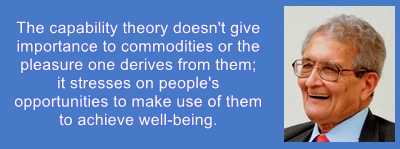 In the capabilities paradigm, poverty is understood as deprivation of basic capabilities. People may get deprived of such capabilities in several ways; for example, ignorance, oppressive state policies, lack of financial resources, ill health, lack of proper education, sudden accidents and so on. The scope of this approach is quite vast; all factors that can potentially affect people’s capabilities are relevant for consideration. Included in the domain of capability theory are all possible factors – social and political processes, gender, inequality, discrimination of all types, social exclusion, disability, environmental conditions, personal and psychological factors – that can possibly influence human capabilities, which is the prime measure of human well-being. In this sense, it is a complete human development model. The capability approach focuses on two things, freedoms to achieve and the capabilities to function.
In the capabilities paradigm, poverty is understood as deprivation of basic capabilities. People may get deprived of such capabilities in several ways; for example, ignorance, oppressive state policies, lack of financial resources, ill health, lack of proper education, sudden accidents and so on. The scope of this approach is quite vast; all factors that can potentially affect people’s capabilities are relevant for consideration. Included in the domain of capability theory are all possible factors – social and political processes, gender, inequality, discrimination of all types, social exclusion, disability, environmental conditions, personal and psychological factors – that can possibly influence human capabilities, which is the prime measure of human well-being. In this sense, it is a complete human development model. The capability approach focuses on two things, freedoms to achieve and the capabilities to function.
Although Amartya Sen is commonly associated with welfare economics, but in recent years his theory has been increasingly used for analysis of social policies in economically advanced nations, for example France.
Functionings and Capabilities
Functiongs are “doings” and “beings”; Capabilities are available freedoms and choices
 Sen searched for measure to adequately represent people’s well-being and deprivation and found that neither income and command over commodities, nor happiness and fulfillment of desires constituted good enough indicator of human well-being or lack of it. Sen argues that people’s well-being depends upon what they are actually capable of doing and being. Thus, he focused on something more direct such as human functionings and capabilities in terms of which the quality of life is analyzed. In other words, a person’s capabilities offer a perspective in terms of which his advantages and disadvantages can be reasonably assessed – that makes it highly appropriate for analyzing poverty.
Sen searched for measure to adequately represent people’s well-being and deprivation and found that neither income and command over commodities, nor happiness and fulfillment of desires constituted good enough indicator of human well-being or lack of it. Sen argues that people’s well-being depends upon what they are actually capable of doing and being. Thus, he focused on something more direct such as human functionings and capabilities in terms of which the quality of life is analyzed. In other words, a person’s capabilities offer a perspective in terms of which his advantages and disadvantages can be reasonably assessed – that makes it highly appropriate for analyzing poverty.
Functionings: Functionings are what people really “do and are”. They are achievements of people: they are ‘doings’ or ‘beings’. Taken together, these doings and beings – achieved functionings – give value to life. The functioings may include being well-nourished, having shelter, able to work, rest; or being literate or healthy; being part of a community or group; being respected, and so on.
Achieving a functioning (for example, being adequately nourished) with a given bundle of commodities (say, bread or rice) depends on a range of personal and social factors (e.g. age, gender, activity levels, health, access to medical services, nutritional knowledge and education, climatic conditions, and so on). A functioning therefore refers to the use a person makes of whatever is at his/her command.
Capabilities: Capabilities are options to achieve valuable functionings; it reflects his freedom to choose. So, capabilities refer to the set of valuable functionings that a person has effective access to. They are best thought to be the equivalent of a person’s opportunity set. In nutshell, capabilities are made up of two things: functionings and the freedom to choose from them.
Difference between Functionings and Capabilities
The distinction between functionings and capabilities is that between the realized and the potentially possible, in other words, between achievements, on the one hand, and freedoms or opportunities, on the other. Capabilities are a person’s real freedoms or opportunities to achieve functionings. For example, while travelling is a functioning, the real opportunity to travel is the corresponding capability.
Functionings refer to what people really ‘do and are’; capabilities denote what people potentially ‘can do and can be’. Functionings are, in a sense, more directly related to living conditions, since they are different aspects of living conditions. Capabilities are notions of freedom, in the positive sense: what real opportunities a person has regarding the life he can potentially lead. Take away the freedom to choose, the two things become same.
The difference between functioning and capability can be best clarified with an example. Consider two persons who are not eating. One is a victim of a famine in Ethiopia and the other decided to sit on a ‘fast’ in front of the US embassy in London to protest against its troops in Afghanistan. What distinguishes the two is the freedom, or availability of option. The first person is badly constrained in freedom and lacks the capability to achieve the functioning to be well-fed; the second person has this capability though he decided not to use it.
Likewise, if you know how to drive a car, you have the ability to drive a car. But it becomes a capability if you have certain conditions fulfilled (having the driving license, road connectivity, availability of fuel, as well as the motivation) so that you can actually drive the car to do things you value. So, merely having a car or merely knowing how to drive it, by itself, does not add value to your life. You also lose this capability if, say, you are a female and the State law doesn’t allow females to drive [such was the case in Saudi Arabia till recently].
Development is Enhancing People’s Freedoms
Enhancing freedoms enhance Capabilities
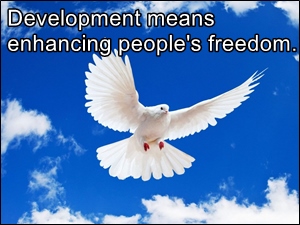 Sen proposes that people lose capabilities when they lack freedom. Having freedom provides the space to develop capabilities. Therefore, all development, according to Sen, is development of human capabilities in the enabling environment of freedom.
Sen proposes that people lose capabilities when they lack freedom. Having freedom provides the space to develop capabilities. Therefore, all development, according to Sen, is development of human capabilities in the enabling environment of freedom.
Sen proposes that expansion of individual freedom is the goal of development; and freedom is also the principal means of development. Therefore, development also means removing the major sources of constraint (lack of freedom) such as all forms of discriminations – racial, religious, gender or community based; unreliable public facilities and poor infrastructure; lack of economic opportunities; social exclusion and political marginalization; and policies limiting human rights; and so on. In many societies where there is ethnic tension, we can also include the fear of violence or terror attacks, as freedom restricting factors.
Freedom provides the necessary space to make choices to make one’s life better the way one wanted. It is particularly relevant for the poor for its enabling and empowering impact.
Capability Approach and Poverty
 In the capability perspective, poverty is seen in terms of a shortfall of ‘basic capabilities’ – a kind of ‘basic capability failure’. Such failure involves the inability to achieve certain minimally adequate levels of crucially important functionings, such as being nourished, being clothed and being sheltered.
In the capability perspective, poverty is seen in terms of a shortfall of ‘basic capabilities’ – a kind of ‘basic capability failure’. Such failure involves the inability to achieve certain minimally adequate levels of crucially important functionings, such as being nourished, being clothed and being sheltered.
In his book, Development as Freedom, Sen has talked about various types of freedoms necessary to increase people’s capabilities (or reducing poverty) and defined development as increasing these freedoms. The freedom of a person is understood as the ability (or opportunity) to choose what one values.
Let’s compare Amartya Sen’s capability approach with resource based approaches. Sen argues that the resource-centric approaches don’t distinguish between means and ends. How the available resources are converted to end use depends upon personal factors as well as on the conditions in which people live – social and political. For example, a disabled person needs more resources to do a task, say moving, than a normal person. Another example is presence of racial bias in the society or extreme bureaucracy in the system; these things affect different people to different extents. Impact of such non material factor hardly ever show up in the GDP model of national development.
Poverty Perspectives: Basic Needs Approach vs Capability Approach
Income Poverty Vs Capability Poverty
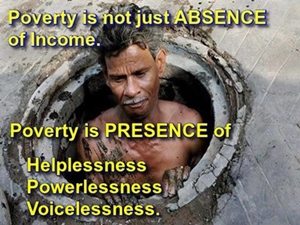 The traditional income poverty and Sen’s capabilities poverty are not entirely distinct from each other. In general, increasing income improves the capabilities of people and vice versa. Basic essentials like education and health directly improve the quality of life and capabilities; they also improve the ability to earn more.
The traditional income poverty and Sen’s capabilities poverty are not entirely distinct from each other. In general, increasing income improves the capabilities of people and vice versa. Basic essentials like education and health directly improve the quality of life and capabilities; they also improve the ability to earn more.
The issue of unemployment offers an insightful comparison between income and capability poverty approaches. If unemployment only meant loss of income, it could be compensated by some form of income support (say, unemployment allowance), but in reality lack or loss of job has much deeper impact on a people’s life than mere economic loss. It might include psychological damage, loss of motivation and self confidence, stress, depression, increase in ailments and morbidity, etc. The income poverty approach is blind towards such “human sufferings” which are clearly picked up by the capability approach through their adverse impact on the capabilities.
Conversion of income into capabilities is an important issue, particularly for the poor. For example, alcoholism is widespread in some poor communities and if the income earner habitually spends it on drinking he is doing nothing to improve his or family’s capabilities. Such a person is degrading his own capabilities as well as of people dependent upon him. A better use would be to raise the nutrition level of family members (but that needs awareness or counseling, which the poor rarely have).
Similarly there are other situations where good income does not automatically ensure better capabilities. For example, in the discriminated sections of society, say for instance, the lowest caste community in India of blacks in the US; even good enough income does not automatically ensures social or political equality. In such cases, belonging to a discriminated community becomes a disability (and a cause for reduced freedom and capabilities).
Gender inequality is another hurdle when the income distribution within families is considered. In patriarchal societies male members always have the first right, leaving the females members rather deprived in everything. This deprivation ultimately shows up in the data for mortality rates, morbidity, literacy, undernourishment, medical-neglect, etc. In Islamic societies where men have the exclusive right to divorce wives anytime, women are always at risk of losing even the basic capabilities needed for survival.
You may also like to explore: 4 Reasons Why Charity Can’t Eradicate Poverty
Poverty Reduction involves more than Economic Growth
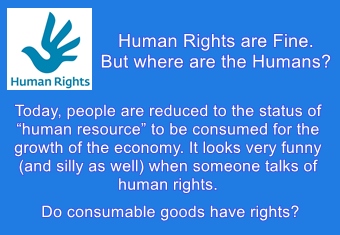 The fact that the per capita GDP has no direct correlation with people’s well-being is clearly observed in the development status of different states of India. Kerala is a unique state in India; it has only a moderately developed economy but has achieved significant poverty reduction. It did so through the expansion of basic education, healthcare facilities and equitable land distribution. In comparison, Punjab with much higher per capita GDP also has higher poverty. Therefore, people’s well-being is not directly related with economic growth.
The fact that the per capita GDP has no direct correlation with people’s well-being is clearly observed in the development status of different states of India. Kerala is a unique state in India; it has only a moderately developed economy but has achieved significant poverty reduction. It did so through the expansion of basic education, healthcare facilities and equitable land distribution. In comparison, Punjab with much higher per capita GDP also has higher poverty. Therefore, people’s well-being is not directly related with economic growth.
Likewise, though the economic reforms in India have opened up the economy throwing new opportunities but majority of the population failed to reap the benefits because the enabling condition of high literacy level, quality basic education, good healthcare facilities, etc proved simply far too inadequate.
People are ‘Agents of Change’
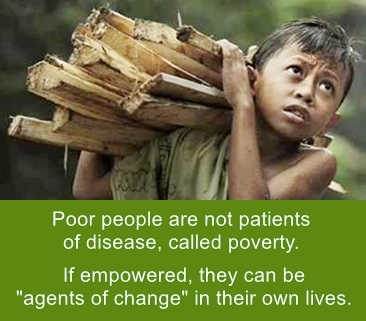 Sen sees people as “Agents” of Change, not passive recipients of benefits or mute followers of expert created policies. In Sen’s view, in the development process “people have to be seen … as being actively involved – given the opportunity – in shaping their own destiny, and not just as passive recipients of the fruits of cunning development programs.” So the central theme of development is to enable people to become agents of change in their own lives. When people, individually or in groups, are recognized as agents, they can define their priorities and also choose the suitable means to achieve them.
Sen sees people as “Agents” of Change, not passive recipients of benefits or mute followers of expert created policies. In Sen’s view, in the development process “people have to be seen … as being actively involved – given the opportunity – in shaping their own destiny, and not just as passive recipients of the fruits of cunning development programs.” So the central theme of development is to enable people to become agents of change in their own lives. When people, individually or in groups, are recognized as agents, they can define their priorities and also choose the suitable means to achieve them.
However, people differ in their ability to use the available freedom and choices and hence, in what they can achieve. In order to be good agents of change, people need the freedom to be educated and healthy, to speak in public without fear, to participate in the social and political processes, etc. On the positive side, once people have these freedoms they can themselves build the environment in which they can be educated, healthy and speak freely and participate, and so on.
Why There is Poverty in the Rich Countries
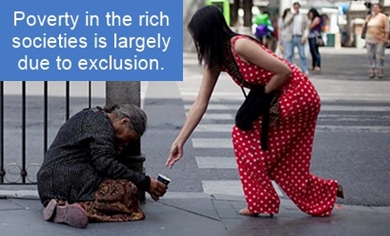 A country can be very rich in conventional economic terms (say, per capita GDP) and yet has large percentage of people with poor quality of human life. It automatically implies that the fruits of development are not reaching all people. It is an issue of inequality which has several forms: political, social and cultural inequalities; unequal access to the basic infrastructure of education, healthcare, housing, transport, clean drinking water, sanitation and so on. Today, it is a widely accepted that focus on economic growth alone inherently favors the rich, and hence the wealth preferentially concentrates in few hands. The poor largely remain excluded from benefits of economic growth.
A country can be very rich in conventional economic terms (say, per capita GDP) and yet has large percentage of people with poor quality of human life. It automatically implies that the fruits of development are not reaching all people. It is an issue of inequality which has several forms: political, social and cultural inequalities; unequal access to the basic infrastructure of education, healthcare, housing, transport, clean drinking water, sanitation and so on. Today, it is a widely accepted that focus on economic growth alone inherently favors the rich, and hence the wealth preferentially concentrates in few hands. The poor largely remain excluded from benefits of economic growth.
Thus, a rich country can only eliminate poverty if it frames policies that focus on removing inequalities of all kinds.
How Democracy Protects People’s Well-Being
For Sen, democracy is not mere elections and casting votes. In North Korea (NK) also people cast their votes, but is there democracy in NK? No. Why? Because people lack freedom — freedom to speak and freedom to choose. A true democracy is actually ‘government by discussion’, namely people’s participation and public dialogue. Analyzing past famines, Sen underlined the importance of democracy and freedom of the speech, and argues that “no major famine has ever occurred in a functioning democracy with regular elections, opposition parties, basic freedom of speech and a relatively free media (even when the country is very poor)”. The prevalence of famines, which had been a persistent feature of the long history of the colonial India, ended abruptly with the establishment of a democracy after independence in 1947. Another historical example he cites is the massive famine in China during 1958-61 during the failed ‘Great Leap Forward’, which claimed close to 30 million of lives. There was no mechanism to help the victims.
Pakistan is another case study where democracy and people’s freedom of choice got trampled by the military dictatorship as early as in 1958. Then democratic institutions eroded in the later decades — and today elections are held and people vote but the Prime Minister is selected by Pakistan army! And the net result: Pakistan is sitting at bankruptcy and people are helpless as they have no voice in governance. Intrusion of Islamic radicals and terrorists in the society and politics makes people’s lives still further miserable.
Applications of the Capability Approach
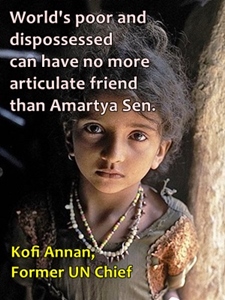 Many attempts have been made to apply the CA. For instance, it has been used to investigate poverty, inequality, well-being, social justice, gender, social exclusion, health, disability, child poverty and identity, as well as for designing policies. It has been related to human needs, human rights and human security as well as development in general. It has also been seen as a theory of social justice – seeking to reduce social exclusion and inequalities.
Many attempts have been made to apply the CA. For instance, it has been used to investigate poverty, inequality, well-being, social justice, gender, social exclusion, health, disability, child poverty and identity, as well as for designing policies. It has been related to human needs, human rights and human security as well as development in general. It has also been seen as a theory of social justice – seeking to reduce social exclusion and inequalities.
There have been numerous attempts to apply the CA to the measurement of poverty and well-being. The CA is perhaps best known for having inspired the creation of the Human Development Index (HDI) in 1990 by the United Nations Development Program (UNDP) in order to gauge countries’ level of human development or people’s well-being. The HDI offered an alternate measure of human progress in terms other than GDP growth and has played a key role in advancing alternative ideas about development and welfare. The HDI covers dimensions of material well-being, health, and education. The multidimensional poverty index (MPI) is another comprehensive tool for evaluating poverty.
Test of any theory, no matter how charming, ultimately rests upon its ability to resolve contemporary problems. Here are some burning issues that Sen’s disciples might like to explore in the light of the CA: (a) How is climate change destroying people’s capabilities to stay alive, (b) Gun terrorism in the United States (economically the most advanced nation on the planet) that kills hundreds of innocent people every year, (c) Impact of radical Islamic terrorism on various Muslim societies around the world, (d) how will the emerging new alliance between Israel and Arab nations change capabilities of different partners, (e) Impact of Chinese debt-trap diplomacy, and (f) Capabilities’ related impact of the silly Ukraine war on various EU nations and the world.
Conclusion
The message is clear.
The well-being of people depends upon many things other than mere increased income or resources. All such things get sidelined when the GDP alone is used as measure for development. Then the immediate concern becomes accumulation of commodities and financial wealth.
Development ought to be holistic — it should create an enabling environment for people to live long, healthy, and fulfilling lives. This is possible in the capability approach because it puts people in the center of debate. The CA also provides a comprehensive framework for anti-poverty programs.
A Note of Caution: Although Amartya Sen’s scholarly and intellectual abilities are beyond question, he also proves a pragmatic observation: “Expertise in one field doesn’t automatically make a person expert of every field!“
Sen’s completely failed (9 year long) tenure for revival of historically renowned Nalanda University proves that point. (It was world’s top education center in its hay day and was destroyed completely 7 centuries ago by a barbaric Muslim invader, Khilji, when India was under Islamic dark-age. The University library was so large that it kept burning for over 3 months; this for the cocky mullah brigade was a display of “Might of Islam”!!) This is what can possibly go wrong when a product of British Macaulay education system, a leftist by mindset and a westernized economist undertakes a real-life historical project dealing with revival of some exquisite Hindu/Buddhist spiritual center. Even if one takes him as an ‘History Expert’ of leftist shade, the project needed skills of leadership with administrative abilities that he totally failed to demonstrate. He was offered the opportunity to head the “Nalanda University Revival Project”, primarily due to nepotism (personal connections with then (dummy) Prime Minister Manmohan Singh, fully controlled by an ultra-corrupt Italian lady, Antania Maino). But his same nepotistic tendencies (favoring Mahmohan’s daughter among others, on appointments) also took it away, after waste of 9 years and over 50 crore rupees of tax-payers money! People saw it very clearly, but the cocky ‘Nobel laureate’ failed to understand what happened !! I hope some of Sen’s disciples would research how opportunities from “nepotism” and “back-door connections” don’t produce sustainable capabilities, and improve upon his brilliant theoretical work.
Explore Further
You may also like to explore
Why Amartya Sen is Wrong: Jagdish Bhagwati
How India Settles Growth-vs-Development Debate
Blinded by Communism, How Sen Ruined Revival of Nalanda University
Why Amartya Sen is Dead Wrong on Secularism, Gujarat and Nalanda University
A very good article explaining in simple words what the approach really is without compromising the details or the essence of the approach. 👌
From Nairobi, Kenya.
Simple and comprehensive.
Pingback: India Is No Longer World’s “Poverty Capital” | Issues of India
Very nice explination in simple words
Capability Approach has been explained very well in simple language
Simple to understand
If we leave aside all we learned about ‘development’ from Textbooks, ‘development’ of any human society is basically all about development of people, each and everyone. Amartya Sen re-establishes this basic forgotten idea in the language of modern researchers and economists. Today, people are reduced to the status of “human resource” to be consumed for the growth of the economy. It looks very funny (and silly as well) when someone talks of human rights. Do consumable goods have rights? At least, I haven’t heard about it.
Pingback: Amartya Sen’s Capability Perspective of Development and Well-being | Issues and Challenges in India
Pingback: Is Gandhi Relevant Today? | Issues and Challenges in India
Pingback: Connecting Dots 06 August 2019
Pingback: How India Settles Growth-Vs-Development Debate | Issues and Challenges in India
Pingback: Don’t Over-Appreciate. I Am Doing Just Bare Minimum—Unlearning Familial Patriarchy
Pingback: The MSRTC Strike and the Need for a Right to Public Transportation in India
Pingback: What Is Amartya Sen Capability Approach? 6 Most Correct Answers - Ecurrencythailand.com
Pingback: the goal is to clearly show that you have done the reading and watched the video - Masters Writers
Pingback: the goal is to clearly show that you have done the reading and watched the video - versedwriters
Pingback: The Goal Is To Clearly Show That You Have Done The Reading And Watched The Video - Robust Papers
Pingback: the goal is to clearly show that you have done the reading and watched the video – Academic Success Verified
Pingback: the goal is to clearly show that you have done the reading and watched the video - Learner Helper
Pingback: the goal is to clearly show that you have done the reading and watched the video – Academic Victors.
Pingback: the goal is to clearly show that you have done the reading and watched the video - Fortune Academic
Pingback: the goal is to clearly show that you have done the reading and watched the video - Academic Essay Gurus
Pingback: the goal is to clearly show that you have done the reading and watched the video - Profiency Essay
Pingback: the goal is to clearly show that you have done the reading and watched the video – ACADEMIC PROS
Pingback: the goal is to clearly show that you have done the reading and watched the video - Answered Assignments
Pingback: the goal is to clearly show that you have done the reading and watched the video - Swift Writers
Pingback: the goal is to clearly show that you have done the reading and watched the video - Essay Pit
Pingback: the goal is to clearly show that you have done the reading and watched the video - Assignment Solutions
Pingback: the goal is to clearly show that you have done the reading and watched the video - Web Writers
Pingback: the goal is to clearly show that you have done the reading and watched the video - Solved Students Assignments
Pingback: the goal is to clearly show that you have done the reading and watched the video
Pingback: the goal is to clearly show that you have done the reading and watched the video – My Blog